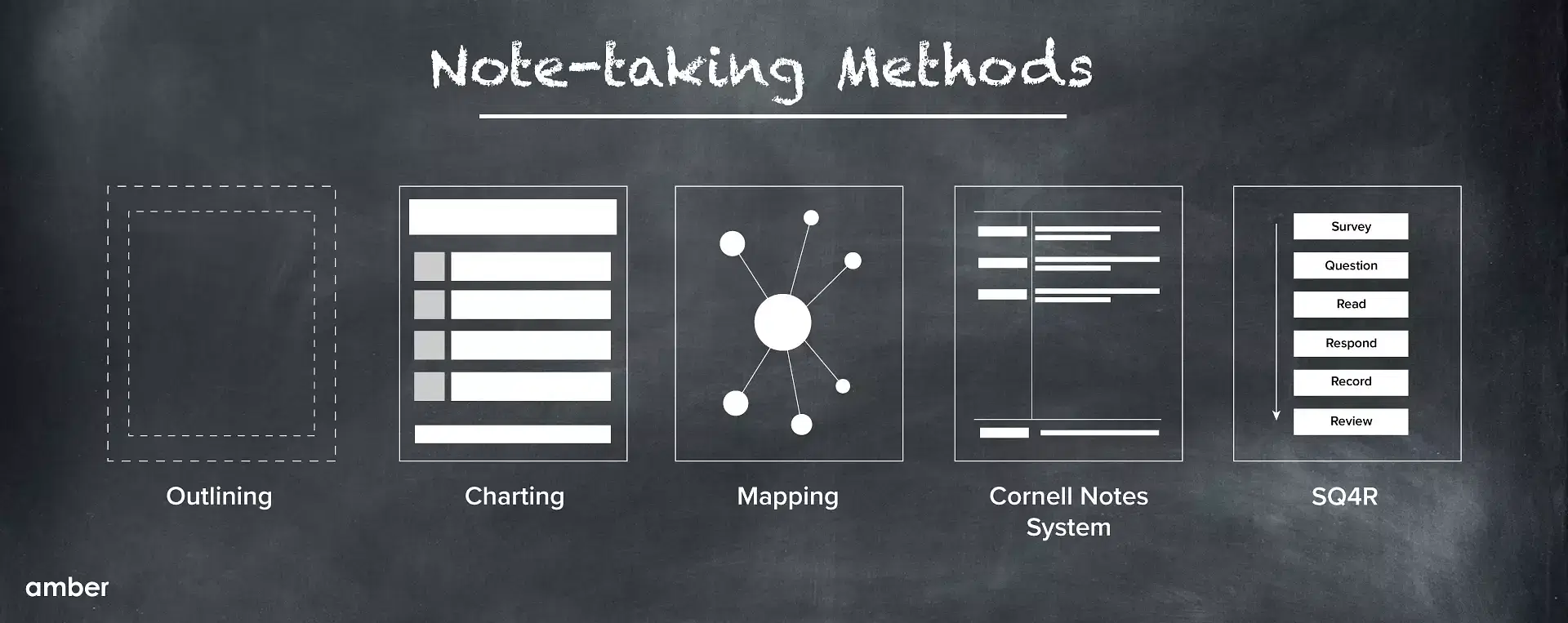Moving to college is a big step in your life. You might even compare it to levelling up in a video game. And just like the bosses get bigger, so do the tests and courses. If you want to reign victorious, you must upgrade your equipment just enough to defeat them. When it comes to tests and courses, your notes are your equipment. To win these battles, you must improve your note-taking skills, so we’ve put together a list of 10 tips on how to take notes effectively. Before we get into it, let’s answer the questions “What is taking notes?” and “Why is note-taking important?”
What is taking notes?
If you’re entering college without a photographic memory, meet your new college besties - notes. Like a powerup, they will make it easier for you to understand your coursework while revising and help you quickly recall your lessons, preparing you for your finals. Note-taking will help you survive your first year of college and stick with you until the end of your academic journey.
A highly effective learning method, note-taking primarily means extracting the most important pieces of information to review later. However, you must keep in mind that note-taking is like a game of Jenga. Each piece of information you take down is like a Jenga block. The more pieces of information you add, the higher the tower grows. But the tower could come crashing down if you don't write down the right information. It's important to be precise and accurate when taking notes so that your tower of knowledge stays sturdy and tall. And this list will help you do just that!
Why is note-taking important?
Studies have shown that we forget 33% of what we learn if we don’t revise it within 24 hours. Taking notes allows students to go back and look through the important pieces of information they collected during their lectures, reinforcing their learning and ensuring it stays in their memory. You will find notes especially useful when studying intricate subjects effectively. You might realise that it’s quite difficult to navigate critical parts of your academic journey, such as when writing a research paper for college without the aid of the almighty notes.
Handwritten vs digital note-taking
Yes, the long debate of paper vs screen has stretched its reach to the world of note-taking. With a phone in every student’s pocket, it’s not hard to see why digital note-taking is the new generation’s preferred tool. Let’s take a quick look at the main differences between note-taking by hand and digital notes.
10 Tips on How to Take Notes Effectively
1. Prepare well before class
That’s right! Note-taking starts before the lecture even begins. Taking the time to skim through the relevant chapters is the first step in figuring out how to make notes effectively. Once you’re done, write down the keywords for the topic, building a checklist of ideas to cover.
2. Determine important content
You may be asking yourself how you can identify the main points of a lecture. So you might be asking yourself what counts as important. If your professor repeats or emphasises any point, write it down. Also, note down any updated information that hasn’t been included in the textbook.
3. Write phrases, not full sentences
If your main worry when taking notes is that you run out of time to write everything your professor covers, this tip will improve your notes dramatically. Instead of writing verbatim what the professor is saying, paraphrase it in a way you understand. Don’t spend too much time writing whole sentences and worrying about your grammar or spelling but don’t note down just the keywords. A page full of keywords won’t help you understand the content later, defeating the purpose of note-taking.
4. Use shorthand to save time
Using symbols and abbreviations will save you plenty of time and helps a lot when looking for how to write notes fast. Make sure to be consistent with these if you’re using your own system so that you remember what each symbol represents. Make a list of your frequently used abbreviations or symbols and their meanings to refer to when revising.
5. Find the best note-taking method
If you set out on a search for the one true note-taking method, you’ll probably come across several different techniques that you can try out. Weeding through these to find the best strategy for you will make your work much easier once you get the hang of it. Here are some popular note-taking methods to explore:

a. Outlining
This note-taking technique is quite common and simple to follow. All you do is note down the points and keywords in a hierarchical pattern, with main topics, subtopics, points, and some points. Don’t forget to leave room for examples and quotes. You might find this method especially useful if you’re taking notes on a laptop or pad, as you can go back and add new points later.
b. Charting
If you’re learning about multiple topics simultaneously, charting can help you better comprehend the comparison between the topics being discussed. In the most basic sense, charting refers to dividing your page into columns and assigning a topic to each column. Avoid using this method when discussing a single topic, as it will only slow you down.
c. Mapping
If you find visualising concepts helpful when studying, this might be your note-taking method match! In mapping, you would use branching graphs, like spider diagrams, to organise information neatly into groups. Make sure you have enough space on your paper, or else you might find yourself with cluttered notes. We suggest taking notes in a more conventional manner during the lecture and creating a mind map when you’re revising.
d. Cornell Notes System
In this system, you divide your page into sections to make it easier to review the information later. You start by drawing a horizontal line a few inches from the bottom of the page. You then draw another line a few inches from the left to create a total of three boxed sections. You use the largest section to take notes and the smaller portion on the left for any additional cues to help you revise. The section at the bottom is for a summary of what you learned from that page.
e. SQ4R
This method is mainly used for note-taking while reading and might not be of much use in a classroom, and consists of 6 different steps:
Survey: Take a few minutes to skim through the content, noting down the headings, subheadings, topics, and key points.
Questions: Write down any questions you have about the text.
Read: Now, read the text while keeping an eye out for the answers to your questions.
Recite: As you complete each section, note down the major concepts, ideas, and keywords. Answer the questions you wrote down to the best of your abilities.
Relate: Try to develop a personal connection to what you read to enhance memorisation.
Review: Once you’ve gone through this process, reread your notes to increase retention and help with studying.
6. Structure your notes well
Cluttered notes are your worst enemy. Although your notes might make sense to you when you’re making them since you are familiar with the ideas they cover, you might find them confusing when revising if they aren’t organised well. To tidy your notes, you can use headings, subheadings, topics, subtopics, and bullet points. Developing and sticking to a system will help you in the long run.
7. Highlight using colours or formatting
Adding a splash of colour to your notes won’t just beautify them. It can also help you organise them better. Using different colours for each topic, you can classify and link important information or concepts. Although colour coding can make quite a difference, don’t let it slow you down during lectures. Instead, save this step for when you’re revisiting your notes after the lecture since it requires a bit of time and concentration.
8. Use a separate highlighter for exam-related information
Highlighting anything exam-related throughout your notes in a particular colour will help you find important information quicker while preparing for your exam. Having organised notes will help you deal with the stress during the exam period. What counts as exam-related information?
- Example exam questions
- Tips for the exam
- Tips for studying for the exam
- When something is important for the exam
9. Take the help of note-taking tools
With so many helpful study apps for students, digital notes have never been more popular. Several out the best way to take notes, but the ones designed exclusively for this purpose come with several features that are quick and easy to use. Use some of the below study tools for note-taking apps out there:
- Notion
- Microsoft OneNote
- Google Keep
- Apple Notes
- Joplin
- Obsidian
10. Review notes while they’re fresh
To make the most of your notes, your note-taking process will likely start before the lecture and extend till after the lecture ends. Once you’ve finished making your notes, it is a good practice to go back and review them shortly after they’re written. Not only will this help you improve your memory retention, but it will also allow you to fix any errors or typos that you come across. At your next group study session, you can compare your notes with your peers’ at your next group study session to identify any errors. Also checkout the best AI tools for students which will make your self-study easier.
Well, there you have it! Note-taking doesn't have to be a chore - it can be a fun way to stay organised and get the most out of your studies. So don't be afraid to try something new when trying to figure out how to take notes effectively - give your notes a little pizzazz, and you'll be surprised at how much more you can get out of class. Who knows, you might even end up with some pretty snazzy-looking notes! You can also check out some of the best note-taking apps which every student needs.





.jpg)



.jpg)
.jpg)





